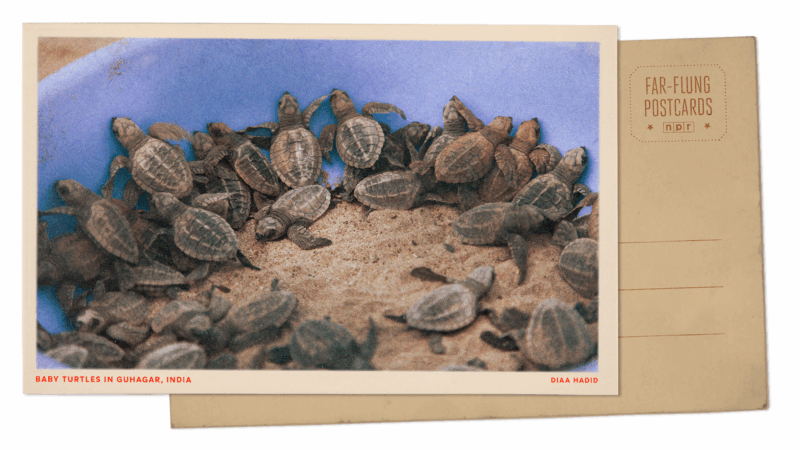Greetings from Guhagar, India, where newly hatched turtles get some help into the sea
Far-Flung Postcards is a weekly series in which NPR’s international team shares moments from their lives and work around the world.
India has some pretty successful efforts to protect the olive ridley sea turtle, a vulnerable species which nests on the country’s long coastlines. Every nesting season, thousands of females dig holes on the seashore with their flippers, and each one lays dozens of eggs inside. To keep them safe from threats like dogs and poachers, activists collect the eggs and incubate them in protected hatcheries.
After they hatch, activists collect them in tubs — like these little guys I photographed in April along the coast south of Mumbai — and then the baby turtles are tipped out onto the sand, so they can crawl into the Arabian Sea.
Tiny, slow and clumsy — these hatchlings are an easy snack for predators. But for this one moment, as they crawl into the waves, they’re protected by conservationists, who shoo away marauding crabs, seagulls and dogs. Sometimes, tourists may watch at a distance. And pretty quickly, the tourists start cheering on the hatchlings to get into the sea. The tourists clap when they’re finally in. It’s like a victory for the little guy, and every time I think about it, it makes me smile.
See more photos from around the world:
- Greetings from the Negev desert, where traces remain of a vanished ancient civilization
- Greetings from the Dubai airport, where a long layover can also be a destination
- Greetings from Paris, where you can swim in the Seine for the first time in a century
- Greetings from Gujarat, India, where a banyan tree is a place for rest, prayers and play
- Greetings from Khartoum, Sudan, where those with the least offer their guests the most
- Greetings from Moscow, Russia, where Lenin’s tomb attracts a new surge of visitors
- Greetings from New Delhi, India, where performing monkeys spark delight — and ambivalence
- Greetings from Damascus, Syria, where a crowded bar welcomed post-Assad revelers
- Greetings from Alishan, Taiwan, whose red cypress forests offer timeless beauty
- Greetings from Odesa, Ukraine, where a Black Sea beach offers respite from war
- Greetings from Shenyang, China, where workers sort AI data in ‘Severance’-like ways
- Greetings from Palmyra, Syria, with its once-grand hotel named for a warrior queen
- Greetings from Mexico City, where these dogs ride a bus to and from school
- Greetings from the Galápagos Islands, where the blue-footed booby shows its colors
- Greetings from Afrin, Syria, where Kurds danced their hearts out to celebrate spring
- Greetings from Dharamshala, India, where these Tibetan kids were having the best time
‘She’s awesome’: How U.S. veterans helped Venezuela’s Machado escape
In a daring nighttime martime operation, U.S. veterans whisked Venezuela's María Corina Machado out of the country to claim her Nobel Peace Prize in Oslo
A momentous week as Syria celebrates lifting U.S. sanctions and a year without Assad
As they mark the first anniversary of toppling Bashar al-Assad's regime, Syrians also celebrate another coming milestone: the lifting of sanctions, which could help give the country a new start.
The Justice Department has now sued 18 states in an effort to access voter data
The Department of Justice has sued four more states as part of the Trump administration's far-reaching attempt to access sensitive voter data. The DOJ is also suing Fulton County in Georgia.
In photos: Flooding in Western Washington state forces thousands to evacuate
Record flooding in Washington state has forced tens of thousands of people to evacuate after torrential rains this week.
Clair Obscur: Expedition 33 sweeps The Game Awards — analysis and full winners list
Independent video game Clair Obscur: Expedition 33 swept the Game Awards last night. The L.A. ceremony draws millions of views for its industry honors and exclusive previews of upcoming games.
There’s a ‘Dead Man’ in church in this snarky ‘Knives Out’ mystery
A firebrand fundamentalist is stabbed to death at church in Rian Johnson's new film, Wake Up Dead Man. This over-the-top whodunit uses mystery conventions to open up a spiritual inquiry.









